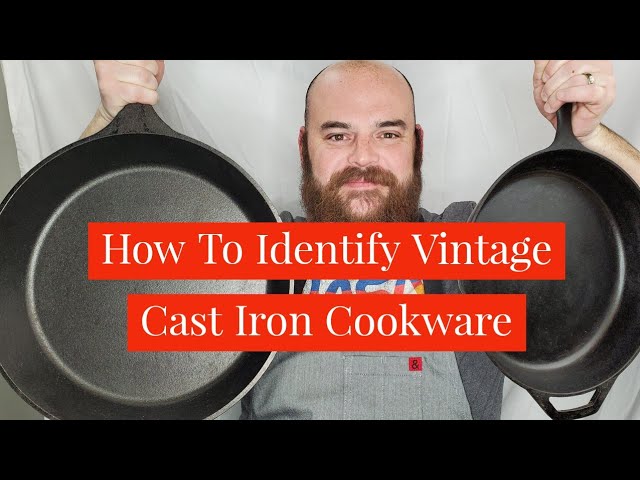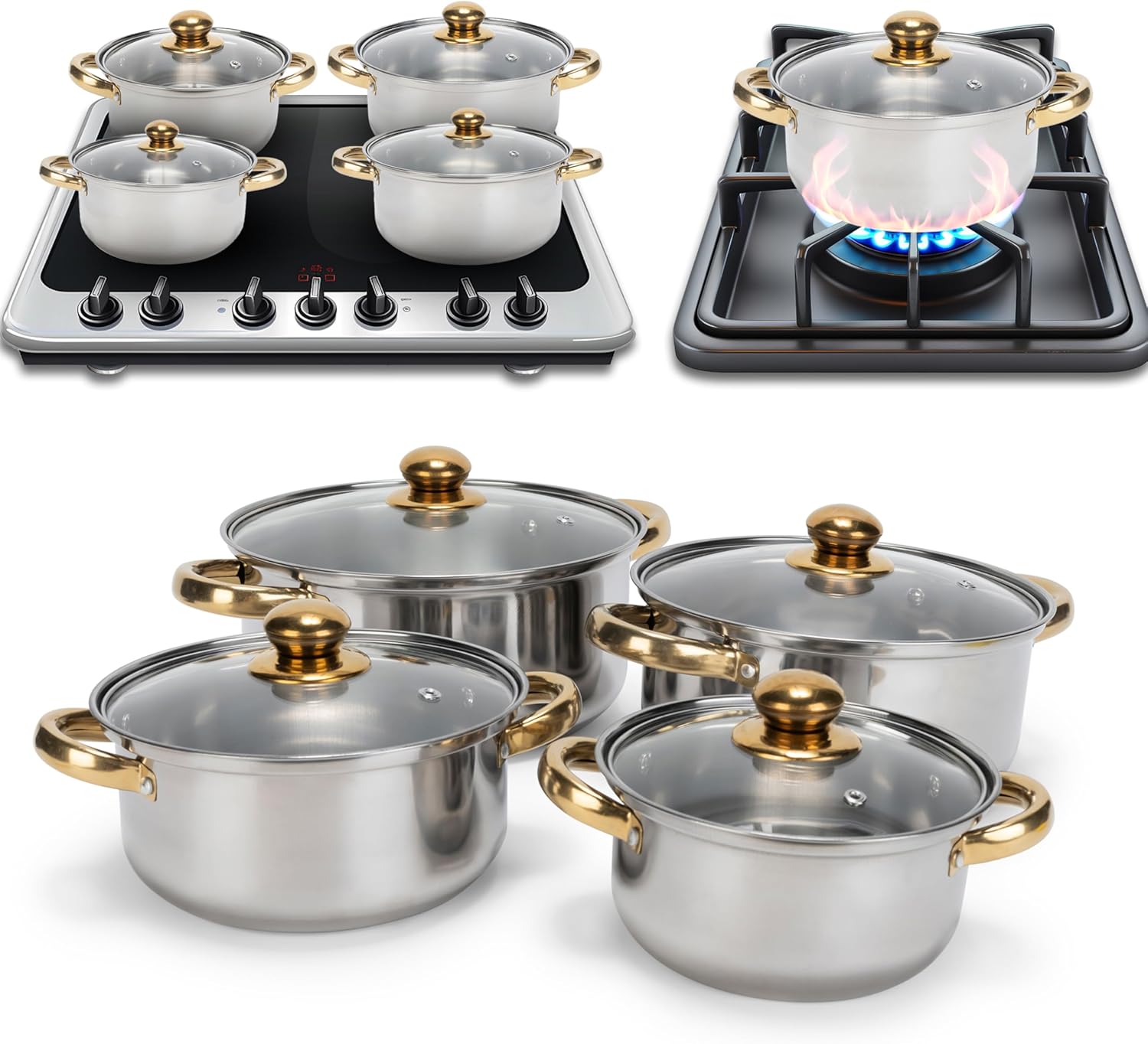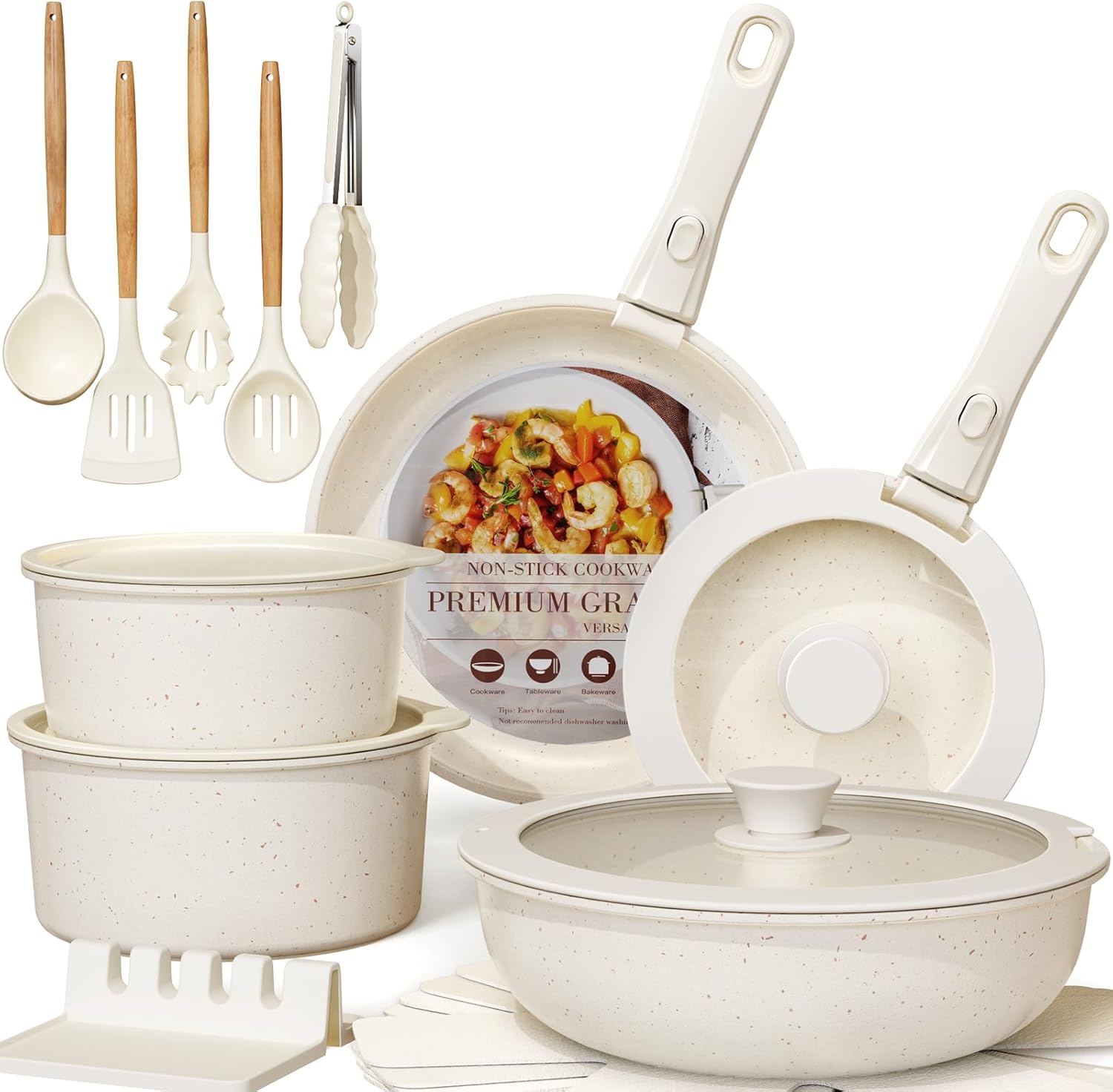Cast iron cookware is a popular choice for many home cooks. Its durability and heat retention make it a favorite.
Yet, not all cast iron is the same. Identifying genuine cast iron cookware can be tricky. Many brands and styles exist, each with unique features. Knowing how to spot real cast iron can help you make informed choices. This knowledge is valuable, especially when buying used cookware or antiques.
Authentic cast iron can last a lifetime if cared for properly. It enhances flavor and even cooking. In this guide, you’ll learn key tips to identify cast iron cookware. You’ll become confident in distinguishing quality pieces from lesser options. Get ready to explore the world of cast iron!
Credit: castirongallery.com
The Rise Of Cast Iron Cookware
Cast iron cookware has become popular again. Many people love its durability and versatility. It cooks food evenly and lasts a long time. Let’s explore its history and modern popularity.
Historical Significance
Cast iron cookware has a rich history. It dates back to ancient China, around 500 BC. The first cast iron pots were used for cooking over open flames.
During the 18th century, cast iron became popular in Europe. It was affordable and accessible. Many families used it for daily cooking.
- Durability: Cast iron lasts for generations.
- Versatility: It can be used on the stove or in the oven.
- Heat retention: It holds heat well, perfect for frying and baking.
In America, cast iron cookware became a kitchen staple. Brands like Griswold and Wagner started producing it in large quantities. This cookware was essential for many households.
Modern Resurgence
Recently, cast iron cookware has made a comeback. Many chefs and home cooks are rediscovering its benefits. It fits well with modern cooking styles.
Several factors drive this resurgence:
- Health benefits: Cooking in cast iron can add iron to food.
- Eco-friendly: Cast iron is a sustainable option.
- Stylish: Many designs are beautiful and trendy.
Social media has played a big role. People share recipes and tips. This has sparked interest in cast iron cooking.
Many new brands now offer colorful options. They attract a younger audience. Cast iron cookware is not just practical; it is also fun.
Key Characteristics Of Cast Iron
Understanding the key characteristics of cast iron helps in identifying quality cookware. Cast iron is known for its unique properties. These properties make it a popular choice for cooking. Let’s explore these characteristics.
Material Properties
Cast iron is made from iron alloy. It contains carbon, which gives it strength. Here are some important material properties:
- Heat Retention: Cast iron holds heat well.
- Non-Stick Surface: Well-seasoned cast iron has a natural non-stick layer.
- Versatile: Suitable for stovetop, oven, and grill use.
Durability Factors
Cast iron cookware lasts a long time. Proper care can make it last for generations. Key durability factors include:
- Resistant to Warping: High heat does not easily warp cast iron.
- Scratch-Resistant: It withstands metal utensils better than other materials.
- Repairable: Minor chips can be fixed with seasoning.
Overall, cast iron cookware is strong and reliable. Understanding these characteristics helps in making better choices.
Visual Inspection Tips
Identifying cast iron cookware can be simple with a careful visual inspection. The look and feel of the cookware give clues about its quality and age. Here are some tips to help you recognize genuine cast iron.
Surface Smoothness
The surface texture of cast iron matters. Real cast iron has a rough texture. This is due to the sand casting process used in making it. A smooth surface often means it is not true cast iron.
- Rough Texture: Genuine cast iron feels gritty.
- Polished Surface: Look out for overly polished finishes.
- Unevenness: Real pieces may show slight imperfections.
Color And Finish
The color of cast iron can also reveal its authenticity. Traditional cast iron is usually dark gray or black. Newer pieces may have enamel coatings, which change the appearance.
| Color | Description |
|---|---|
| Dark Gray | Typical color of plain cast iron. |
| Black | Common for both old and new cast iron. |
| Colored Enamel | Used in newer cookware, not traditional. |
The finish also matters. A well-seasoned piece has a natural sheen. This sheen comes from oil and heat during cooking. Avoid pieces with chipped or peeling finishes. These signs indicate poor quality.

Credit: www.therusticskillet.com
Weight And Balance Check
Identifying cast iron cookware requires attention to its weight and balance. The right cookware feels solid and well-balanced in your hands. This section explores how to check the heft and handling of cast iron, and the evenness of its weight distribution.
Heft And Handling
Cast iron cookware is heavy. Its weight is one of its most defining features.
- Lift the Cookware: Feel the weight in your hands.
- Check for Stability: It should feel sturdy.
- Compare with Other Cookware: Cast iron is heavier than non-stick pans.
When you hold it, it should feel well-made. A light pan may not be cast iron.
Evenness Of Weight Distribution
Good cast iron cookware has even weight throughout. This ensures balanced cooking.
To check weight distribution:
- Hold the Handle: Check if the pan tilts.
- Look at the Base: It should feel stable on a flat surface.
- Tap the Sides: Listen for a solid sound without rattles.
Uneven weight can cause hot spots while cooking. A balanced pan cooks evenly.
| Weight Feature | What to Look For |
|---|---|
| Heft | Heavy and solid feel |
| Balance | No tilting when held |
| Sound | Solid sound when tapped |
These checks help ensure you have authentic cast iron cookware. Trust your senses. Weight and balance play key roles in cooking success.
Assessing The Seasoning
Assessing the seasoning of cast iron cookware is essential. The seasoning protects the metal. It creates a non-stick surface for cooking. Proper seasoning also prevents rust. Here’s how to evaluate it.
Quality Of Non-stick Surface
A good non-stick surface is crucial for cooking. You can check the quality by:
- Looking for a smooth, shiny finish.
- Testing with water: Pour a few drops on the surface.
Water should bead up and roll off easily. This shows the seasoning is effective. If the water spreads, the seasoning may need work.
Signs Of Proper Maintenance
Proper maintenance keeps your cast iron in good shape. Watch for these signs:
| Signs | Description |
|---|---|
| Even Color | The surface should be dark brown or black. |
| No Rust | Check for any rust spots or flakes. |
| Minimal Buildup | Avoid excessive grease or food residue. |
Regular cleaning and re-seasoning help maintain quality. Store the cookware in a dry place. This prevents moisture and rust.
Brand Marks And Stamping
Brand marks and stamping are vital for identifying cast iron cookware. These marks tell you about the manufacturer and the age of the piece. Understanding these symbols helps you know the quality and value of your cookware.
Identifying Manufacturer Symbols
Different manufacturers use unique symbols. Here are some well-known brands:
- Le Creuset: A flame symbol with the name.
- Griswold: An “Eagle” symbol with the number.
- Wagner: A name or “Wagner Ware” with a logo.
- Camp Chef: A simple “C” logo.
Each brand has its own style. Knowing these symbols helps you identify your cookware’s origin.
Understanding Markings And Numbers
Markings and numbers provide more details. They can indicate the size, model, and even the year made. Here’s a breakdown:
| Marking | Meaning |
|---|---|
| Number (like 3, 8) | Indicates the size of the skillet. |
| Letter (like A, B) | Represents the model or series. |
| Year (like 1900, 1950) | Shows the year of production. |
Check the bottom of your cookware for these marks. Understanding them helps you learn about your item.
Collecting cast iron is a rewarding hobby. Knowing brand marks and numbers enhances your experience.
The Sound Of Quality
Understanding the sound of cast iron cookware can help you identify quality pieces. A simple tap can reveal a lot about the pan. Listen closely. The sound you hear speaks volumes about the cookware’s craftsmanship.
Listening For A Ring
Quality cast iron should produce a clear, ringing sound. This ring indicates good material and construction. Here’s how to test it:
- Hold the skillet in one hand.
- Gently tap the surface with a metal utensil.
- Listen for a bright, resonant ring.
A dull sound means something is off. A good ring shows the cookware is well-made.
Dullness As A Defect Indicator
A dull sound can suggest poor quality. It may mean the iron is thin or improperly cast. Look for these signs:
- Dull, flat sound when tapped.
- Uneven surfaces or rough spots.
- Weight feels lighter than expected.
Trust your ears. A dull ring often leads to disappointment in cooking. Choose pieces that sing with quality.

Credit: www.pinterest.com
Common Pitfalls To Avoid
Identifying quality cast iron cookware can be tricky. Many factors can mislead buyers. Knowing what to avoid is essential. Let’s look at some common pitfalls.
Cracks And Warping
Cracks and warping are serious issues in cast iron cookware. They affect cooking performance and safety. Check for these signs before buying.
- Cracks: Look closely at the surface. Small cracks can grow over time.
- Warping: Check the bottom. A warped pan won’t sit flat.
To avoid these problems:
- Inspect the cookware carefully.
- Ask the seller about its history.
- Choose pieces from reputable brands.
Rust And Pitting
Rust and pitting are common in cast iron. They can ruin the cookware. Identifying these issues early is crucial.
| Problem | What to Look For |
|---|---|
| Rust | Brown spots or flaking metal. |
| Pitting | Small holes or dents in the surface. |
To avoid rust and pitting:
- Store cookware in a dry place.
- Season regularly to protect the surface.
- Avoid soaking in water.
Keep these tips in mind for better cookware choices.
The Price Point Perspective
Understanding the price of cast iron cookware is crucial. Prices vary widely. Knowing what to expect helps in making smart choices. A good balance of cost and quality is key.
Balancing Cost And Quality
When buying cast iron cookware, consider both price and quality. Cheaper options may seem appealing. But they often lack durability. Here are some factors to weigh:
- Material Quality: High-quality cast iron lasts longer.
- Brand Reputation: Well-known brands often ensure better craftsmanship.
- Finish and Coating: A smooth finish makes cooking easier.
Investing in quality can save money long-term. A good piece will outlast cheaper items. Look for these signs of quality:
- Weight: Heavier pans often indicate better quality.
- Uniformity: A consistent surface means even cooking.
- Handles: Sturdy, well-designed handles enhance usability.
When To Invest More
Some situations call for spending more. High-quality cast iron cookware can be worth the price. Here are some reasons to invest:
- Frequent Use: If you cook often, quality matters.
- Versatility: A good pan can handle many cooking methods.
- Family Size: Larger families may need durable cookware.
Consider the long-term savings. A well-made pan can last for generations. Think of it as an investment in your kitchen.
Cast Iron Care And Restoration
Taking care of cast iron cookware is important for its longevity. Proper care maintains its non-stick surface. Restoration can revive old pieces. This section covers essential tips for cleaning and restoring cast iron.
Cleaning Dos And Don’ts
Cleaning cast iron requires special care. Follow these dos and don’ts to keep your cookware in great shape.
| Dos | Don’ts |
|---|---|
| Use mild soap for cleaning. | Avoid harsh chemicals or abrasive pads. |
| Rinse and dry immediately after washing. | Don’t soak cast iron in water. |
| Apply a thin layer of oil after cleaning. | Never leave food residue on the surface. |
| Use a soft sponge for scrubbing. | Don’t use steel wool or metal scrapers. |
Restoring Vintage Pieces
Restoring vintage cast iron can be rewarding. Follow these steps for a successful restoration.
- Assess the condition: Check for rust or chips.
- Remove rust: Use fine steel wool or a rust eraser.
- Wash the piece: Clean with mild soap and water.
- Season the cookware: Apply a thin layer of oil.
- Heat it up: Place in the oven at 375°F for an hour.
- Repeat seasoning: Do this a few times for best results.
Restoring vintage cast iron requires patience. The effort pays off with a beautiful, functional piece.
Frequently Asked Questions
How Can I Identify Cast Iron Cookware?
Identifying cast iron cookware involves checking for a few key features. Look for a rough texture on the cooking surface, indicating it’s made of cast iron. Additionally, inspect for a heavy weight and a dark, seasoned finish. Manufacturer markings on the bottom can also help identify authenticity.
What Are The Signs Of Quality Cast Iron?
Quality cast iron cookware often has a smooth, well-seasoned surface. It should feel heavy and solid, indicating durability. Look for a consistent, dark color without rust or cracks. High-quality brands may also have their logo or name cast into the bottom for easy identification.
Is Vintage Cast Iron Cookware Better?
Vintage cast iron cookware is often considered superior due to its craftsmanship. Older pieces were typically made with higher-quality materials and manufacturing processes. They may have a smoother cooking surface and better heat retention. However, condition matters, so inspect for any damage before use.
How Do I Care For Cast Iron Cookware?
Caring for cast iron cookware involves regular seasoning and proper cleaning. After cooking, clean with warm water and a soft sponge. Avoid soap, as it can strip the seasoning. Dry thoroughly and apply a thin layer of oil to maintain its non-stick surface and prevent rust.
Conclusion
Identifying cast iron cookware is simple with the right tips. Look for a smooth surface and a dark color. Weigh the piece; cast iron is heavy. Check for a handle that feels sturdy. Use these signs to find quality cookware.
Knowing these details helps you choose wisely. Cast iron is durable and can last a lifetime. Enjoy cooking with your new or old cast iron pieces. They can enhance your meals and add flavor. Happy cooking!





Leave a Reply